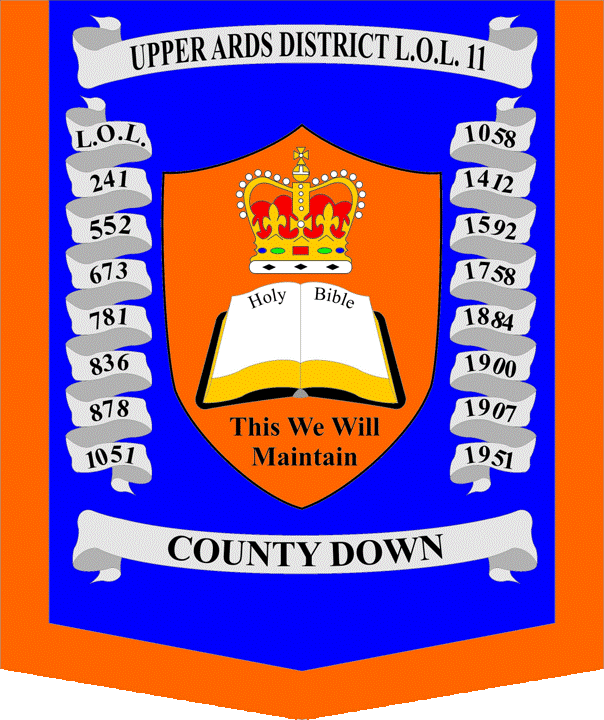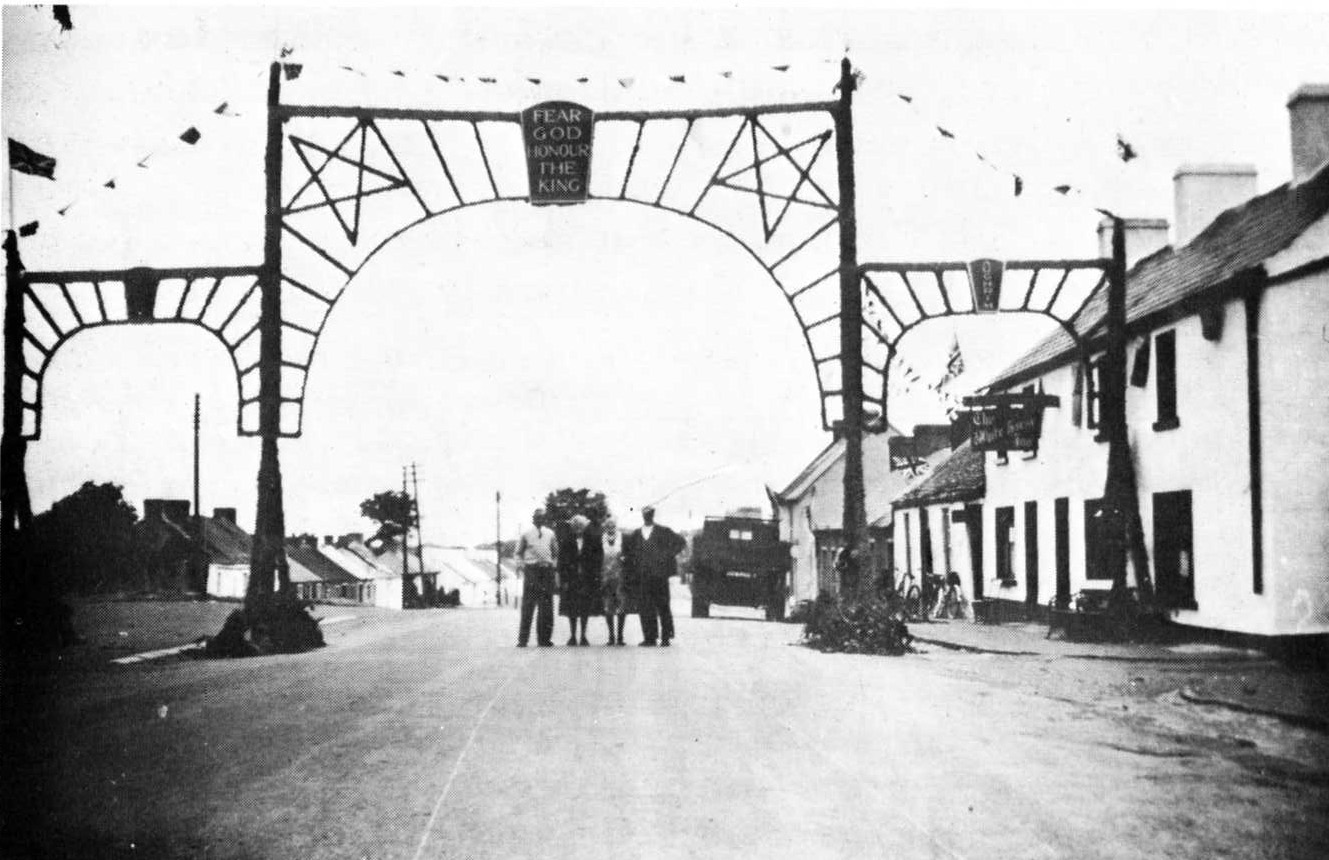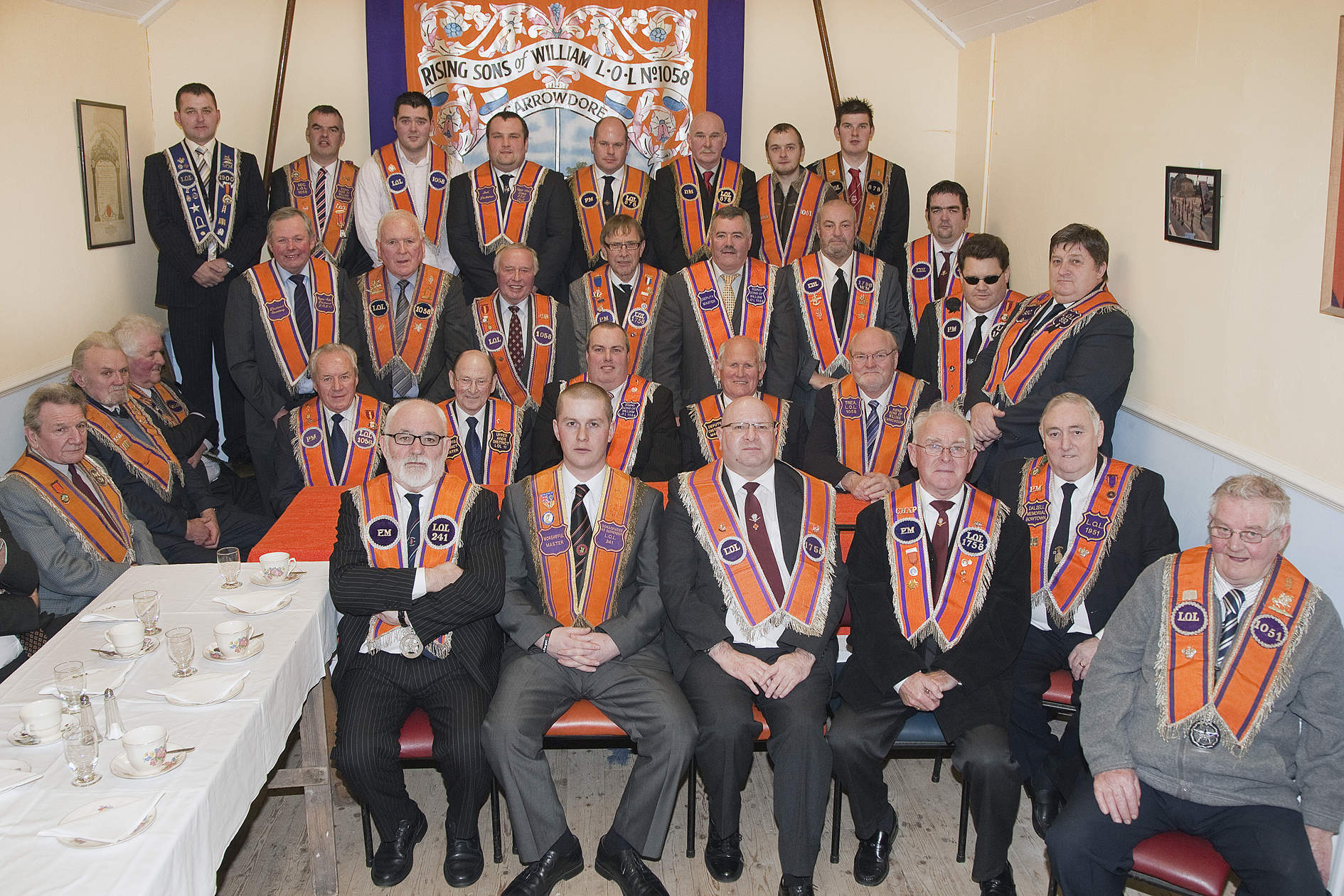Private Lodges 1051, 1058, 1412
Carrowdore True Blues L.O.L. 1051
Carrowdore, strange as it may seem has strong links with the old town of Donaghadee and those links were never stronger than in the 1700s through until the present day. This is because of the charitable generosity of the De-Lacherois-Crommelins, a family well thought of in both places because of the extensive property they held. Residing in Carrowdore Castle was the nephew of the late Thomas and Marie Angelique De-Lacherois Crommelin, Nicholas De-Lacherois Crommelin who was a strong Orange Society member; this was before the founding of the Orange Order became really strong throughout Ireland, especially in the many rural areas. This was so in the Ards area. Nicholas was at this time Grand Master of Down as at that time one did not have to be a member of a private lodge to hold high office. The Crommelin family encouraged Orangeism and being strong Episcopalians, as were most of his workers and people of the district. In 1823 he encouraged them to form an Orange Lodge in the village.
At that time very few, if any lodges had a hall, so they met in the houses of members and so it was that in 1823 that the first lodge in Carrowdore came into being. It applied to Ards for membership and was granted a warrant for the number 1051 to become the third oldest lodge in the Ards.
The first Worshipful Master was James Burch, a name that has continued down all those years to the present day as members of L0L 1051. James Burch continued as master until 1836 and saw the lodge through the many troubled times of the period. It was a time when the then government put many restrictions on the Orange Order, the main thing being the banning of parades. Parades were allowed from 1836 and it was the last year that James Burch acted as Worshipful Master and it was fitting that this parade took place in Donaghadee. Nicholas Crommelin had now become a member of the lodge and in 1837 he became Worshipful Master and still County Grand Master to hold high office now one had to be a member of a private lodge. Brother Crommelin remained in office until, 1849 and because of his influence steered them through a period that saw the Grand Lodge dissolved. It was to be a trying time for the order as a whole. Although meetings were still held and the membership was good it was not until 1845 that Orangemen were allowed to parade the roads. Catholic agitation against the Act of the Union resulted in a big revival in the ranks of the Orange Order for with it came the repeal of the Party Processions Act. There was a-big turnout for the 1845 Demonstration held in Newtownards. At the head was Bro. Nicholas Crommelin. The Orangemen were back on the march. Things went well for 4 years until 1849 when again Catholic agitation culminated with the infamous Dolly's Brea skirmish at Castlewellan when an Orange parade was attacked, the Orangemen defended themselves too well. The ban was reimposed and was to last this time for 18 years. After 18 years of calm, in spite of repeated pleas for the parades to be continued, this was denied by the government of the day. It was inevitable that it would not be long before the ban would be breached. In 1867 Bro. William Johnston decided, enough was enough and organised a 'token' protest march to go from Newtownards to Bangor. Hundreds turned out to support Bro. Johnston, amongst them L0L 1051.
About 1840 some members of L0L 1051 decided to break away from the lodge and formed a new lodge L0L 1058. Why the split came has now been lost in the passing of time but today both lodges work side by side as they have always done. After the ban was broken membership was again on the increase. Grand Orange Lodge was back working again but the Districts were to be reorganised to make the working more streamlined. This happened in the Ards. The Upper Ards district was small because many lodges belonged to the Ards district. In the 1875 change and the new zoning L0L 1051 and L0L 1058 became members of Upper Ards No. 11. District the new District Warrant being issued to Bro. Alexander Palmer who was now the W. Master on the retirement of Nicholas Crommelin. Both Carrowdore Lodges flourished during this period L0L 1051 having more than 40 members on its books. Led by the redoubtable Alex Palmer, also in their favour was the son of Nicholas, Fredrick Armand, who had become a member and later he was to have a big influence on the lodge as we know it today.
With the issue of the new Warrant in 1875 it was decided that it was time to have a hall of their own. They still met in a house of a member but owned by the Crommelins, this house had a good piece of land at the rear. The Brethren were given permission by Fredrick to be allowed to build a hall on the site. Work was started in 1876 and the following year the new hall was completed. The Brethren sat in the hall for 13 years but did not own the hall so in 1890, 200 years after the Battle of the Boyne, the lodge negotiated with Fredrick Crommelin for the ownership of the hall to go to the Orangemen. Fredrick concurred with this request, being the true Orangeman he was and in the true fashion of his forefathers. In 1890 signing as trustees of the hall for the Orangemen were, W. Master, Alexander Palmer; Bro. Edward McBrier; Bro. John McGivern and Bro. William Yeaman and the lease was for 999 years at 1 shilling per diam (5p). the date August the 16th 1890. Sadly, like all the Orangemen of the day lived for the day and were not to know that 82 years later the land where the hall stood would be vested for new housing. Nothing of the hall exists today except where it stood. Bro. Fredrick became W. Master in 1891 and was to lead the lodge for the next ten years. In 1885 Carrowdore were hosts to the 12th celebrations and Bro. Fredrick granted the use of the Castle ground for the 'Field' and no prouder man led the parade. Associated with any organisation are myths and stories, L0L 1051 was no exception. In the days before their own hall, the Orangemen met in the house of Mattie Mulholland, the house on the land where later the hall was built. Now it seems that Mattie, after cleaning up would go to the house of a neighbour whilst the Orangemen held their meeting, for some unknown reason on this night Mattie was left in the kitchen. The W.Master at this time was a Bro. William Corr, on learning that Mattie had been in the house whilst they held their meeting, William Corr and the assembled Brethren decided that just in case Mattie had heard the ritual they would have to make her a member which according to legend they did. Be it true or not it makes a grand story and is still related today. One thing is sure Mattie had a son, Thomas and Thomas was no myth for he was to become an Orangeman at the age of 16, in 1878 and was still a member when he died in 1947 in his 86th year. Thomas was master for 20 years and he was also district master for a number of years. His brother was also a long time member as was his son William Mulholland who died a few years ago in 1979. Thomas was also a lecturer both for district and for the lodge. A raconteur with many fine stories to tell and many were the entertaining evenings he gave the Brethren in those days before radio and television. The lodges were now on a standard footing and all seemed to be going well with the now traditional 12th of July parade the main event of the year. The halls had now become the social centre of the community. Social functions of all kinds took place for the entertainment of all. Sadly that spirit is lost today, as the song says 'Times they' are a changing.'
There have been many associated with L0L 1051 who have risen to great heights. Nicholas-De-Lachorois Crommelin became the Sherrif of Down and the Lieutenant of the County. Fredrick became Deputy Lieutenant. Major Workman of shipyard fame was a member for many years. A one Captain Henry was a member. Samual David Ennis who went to win the Military Medal for bravery in World War II was also a member. Another bit of history attached to 1051 was that of Bro. Stephen Hale, Past Master who is a distant relative of Sir Isaac Wilson one of the original founders of the Orange Order. Another distant relative was Gen. Sir Henry Wilson, murdered by the IRA in the 1920's. Stephen followed the tradition of his forefathers. He became an Orangeman at 17, Lecturer at 18, Worshipful Master at 19 and became Worshipful Master of his Black Preceptory at the age of 20.
Carrowdore, Rising Sons of William L.O.L. 1058
LOL 1058 was formed in 1845 with James Tennents as Worshipful Master and hence took the name of Tennents Lodge. The first meetings were at Bally Avenue, Carrowdore, but then the lodge moved to Edward Hawkins house in Main Street, before moving into Kiln House in 1910. In 1910 a new banner was unfurled under Hugh Hamilton Worshipful Master, William Yeaman Deputy Master, Andrew Orr Secretary. and Edward Hawkins Treasurer. By this stage the lodge was known as the Rising Sons of William and had a strength of 24 members. In 1928 a new banner which depicted the Mountjoy and cost £30 was unfurled, and this in turn was replaced by another new banner in 1960. The lodge room was extended in 1923 and in 1924 Major Workman from Carrowdore Castle was proposed. Since this the lodge hall has been extended again and in 1960 the hall was purchased from Mrs. Stone. The lodge ran a dance every week in the 1920’s and guest teas were continued into the 1950's.
The accounts of the Orange Ball in 1929 read as follows:- rent of hall 10 shillings; rates 2 shillings & nine pence; profit after expenses £3-16-5. In the 60's and 70's dances were held in local hotels to assist with fund raising. When the lodge first marched it was to the rhythm of the lambeg drums, but later two pipers were used. In 1918 the first flute band was formed which has been followed by various flute and accordion bands.
Kirkistown True Blues L.O.L. 1412
Prior to the formation of Kirkistown LOL 1412 on 1st July 1840 a number of Orangemen from the Kirkistown area were granted dispensation on an annual basis to parade on the 12th July. Family names dating back to the earliest days included Ennis, Polley, Thompson, Moore, Lawther, Young, Adair, Kyle, Keag and Blackmore. William Ennis senior and junior were both active but it is William Ennis junior whose name appears on the Warrant.The Lodge still holds its first bannerette, which is made of linen, with the signs, numbers and a mural of King William III all made up of and sewn in linen thread. Although there is no record of when this bannerette was made, the late Brother David Ennis insisted that it was used in the very early years of the lodge. It is possible that it was carried on the 12th July 1866 when our late Brother William Johnston of Ballykilbeg marched at the head of a procession of thousands of Orangemen and friends from Newtownards to Bangor.
LOL 1412 first met in the home of Brother William Ennis in Kirkistown. The house was the usual one storey dwelling of that time, with the kitchen in the centre and two or three small rooms opening off this. It stood on a small holding of 16 or 17 acres, and now is part of the lands of Ballycranmore House a 200 acre farm.
Eventually the lodge moved to the other end of the Kirkistown townland. The next meeting place was at the home of Brother Robert Polley at Islandreagh. By the 1900's the members of LOL 1412 decided that as most of the neighbouring lodges had a hall to meet in, it was time that Kirkistown should build a hall. Finally a site on the Quarter Road was agreed to. The lease was granted by the landlord General Hugh E. Montgomery, Rosemount, Greyabbey, at the nominal rate of five shillings per year. In the spring of 1903 a contract for the erection of the hall was given to Mr. Samuel Cully, a builder from Portavogie. It was satisfactorily completed and opened on the 12th July 1903 for the approximate cost of £300.
The second Lodge banner unfurling date is not on record, but it is believed to be around 1914 just before World War 1, banner number three was unfurled in June 1938 by Mrs. Beveridge, wife of the late Rev. William Beveridge who was a member of the Lodge when he was Rector of Ardkeen Parish Church. A fourth banner was unfurled in the June of 1958, and banner number five unfurled on the Saturday afternoon of 25th June 1983. It was Brother the Rev. Canon T.H. Frizelle also a former rector of Ardkeen Parish Church and a member of LOL 1412, who conducted the ceremony of the unfurling. This present banner has a portrait of King William crossing the Boyne on one side, with the Holy Bible and Crown on the other, and is inscribed: For The Throne Is Established In Righteousness.
The 100th Anniversary of the constitution of Kirkistown LOL 1412 was celebrated in the Orange Hall on Saturday 29th June 1940. Present at the celebration were Worshipful Brother the Right Honourable Lord Craigavon, Wor. Bro. The Right Honourable John M. Andrews, The Wor. District Master Wor. Bro. William Ferguson, Deputy District Master Wor. Bro. Jim Lawson, the District Sec. Wor. Bro. James Crockard, District Tres. Wor. Bro. Sam McMillen with Officers and Brethren from neighbouring Lodges. A photograph taken on that day was framed and hung in the hall for over 25 years. During a time of painting and decorating it was taken down but could not be found when the pictures were being put back on the walls.
The 50th Anniversary of the completion of the Hall celebrations were held on the 23rd November 1953 in the Orange Hall. Wor. Bro. Ferguson took the chair for the proceedings after tea, and enjoyed hearing a history of LOL 1412 which was prepared by Bro. Stavely O'Brien with the assistance of Bro. David Ennis, so much that he requested permission to take the work with him with a view to having it printed in booklet form. It was unfortunate that Bro. Ferguson was unable to have this done, due to an illness from which he never recovered. The copy of the lodge history could not be found after Bro. Ferguson's death.
In retrospect Kirkistown True Blues LOL 1412 has kept going steadily through the years, and can look forward with pride and hope to see the cherished tradition of doing things, decently and in order is maintained.


